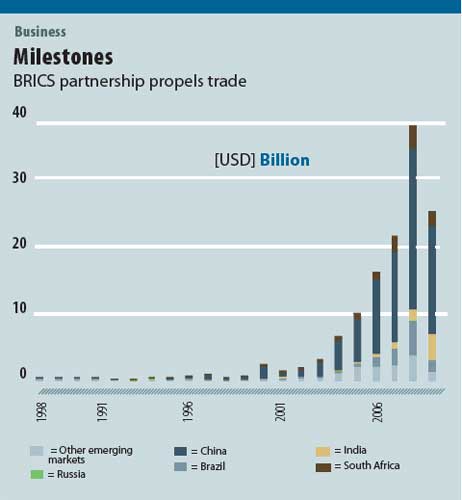|

Since the end of the civil war in 2002, Angola has moved from the fringe to the center of African economic affairs. Today, Angola accounts for 6 percent of Africa's GDP, 10 percent of its trade and 5 percent of continental-wide investment flows.
Importantly, Angola's economic awakening has occurred in tandem with the resurgence of BRIC (Brazil, Russia, India and China) commercial interest in Africa. As such, Angola is, in many ways, emblematic both of Africa's elevated commercial allure, and the manner in which the continent has become an integral cog in the BRIC's global political and economic ambitions.
BRIC collective trade with Angola has surged by an average of 71 percent year on year over the past decade, from less than $400 million in 1998 to $30 billion in 2008. Today, more than one-third of Angola's total trade is with the BRICs. Of the BRICs, China's trade with Angola is by some margin the largest, has grown the fastest, and has proven more stable than Angola's other partnerships.
Angola's time
Diplomatic initiatives have paved the way for acceleration in trade. Quite clearly, the BRICs have used diplomacy as an important beachhead into key African markets. Russia, China and Brazil have been most ambitious in this regard. Between 2000 and 2009 Angola hosted no less than 10 senior BRIC political delegations. Meanwhile, Angolan President Jose Eduardo Dos Santos has paid strategic visits to the BRIC markets to secure cooperation agreements and bolster commercial ties. Perhaps most significantly, President Dos Santos visited China in December 2008 in order to ensure Beijing's support despite the increasing headwinds brought about by the global financial crisis. These initiatives have resonated in Angola – and proven particularly effective given the heavy involvement of the state in the economy.
The BRIC collective has supported Angola's rejuvenation, providing the funds, materials and skills to rebuild the country's infrastructure stock. Since emerging from civil war, a priority of the Angolan Government has been the rebuilding of the country's shattered infrastructure stock. In this regard, partnership with the BRICs, most prominently China and Brazil, has been of fundamental importance – spurring opportunities for BRIC state and private corporations and building demand for imports of the components vital for the reconstruction efforts. Meanwhile, the BRICs have identified opportunities in Angola's small, but increasingly affluent, consumer body. As a result of these developments, Angola imported $5 billion worth of goods from the BRICs in 2010 – around a quarter of Angola's total imports.
Angola's imports from China and Brazil are roughly the same size (near $2 billion), but Brazil has focused virtually exclusively on soft commodities, whereas China has managed to carve out important market share by meeting a wide variety of product groups. Meanwhile, Angola's imports from India are just over half the size ($1.1 billion), but India's strategy has been equally as focused as Brazil.
|